7. THE HIGH MIDDLE AGES

THE CRUSADES
1095 to the Late 1200s
CONTENTS
 The First Crusade (1095-1098) The First Crusade (1095-1098)
 Efforts to consolidate the victory Efforts to consolidate the victory
 Mixed success Mixed success
The textual material on the page below is drawn directly from my work
A Moral History of Western Society © 2024, Volume One, pages 229-234.
|
A Timeline of Major Events during this period
1071 Seljuk Turks defeat the Byzantine Army at the Battle of Manzikert, cutting off access by
Christian pilgrims to the Holy Lands
1095 Pope Urban II supports Byzantine Emperor Alexios Komnnos's request for help in warding
off the
Seljuk Turk threat ... declaring a "crusade" to help the Byzantine
Empire
1096 Peter the Hermit, with as many as 100,000 commoner men, women and even children,
head off on such a crusade (slaughtering Jews along the way) ... which
ends in
disaster at the Battle of Nicaea
Meanwhile a number of princes organize their own crusading groups ...
and the "First
Crusade" (1096-1099) brings the Holy Lands under crusader
control;
Then most of the princely crusaders go home ... though some Normans
establish their
own personal rule in the cities taken from the Muslims
1118 An order of military monks (the Knights Templar) is founded in Jerusalem ... soon
becoming very powerful and very wealthy
1124 The crusaders add Tyre to their holdings of Antioch, Tripoli, Jerusalem, and Edessa
1144 But Edessa falls to the Muslim governor of Mosul, Zangi
1147 Pope Eugene III and Bernard of Clairvaux call the Second Crusade (1147-1150) to stop a
Muslim
revival
Numerous European kings now "take up the cross" (join the
crusade)
Also
Christian warriors take Lisbon from the Muslims as part of the 2nd
Crusade
1150 The Second Crusade ends up in failure ... but awakens European monarchs to the glory
of Muslim culture ... stirring a new materialistic cultural spirit in
Europe
1171 Sunni Muslim warrior Saladin seizes control of Egypt (taken from the Fatamid Muslims)
1182 Saladin takes control of Syria (taken from the Crusaders)
1187 Saladin takes similar control of Palestine ... including, most importantly, Jerusalem
1191 Crusaders are able to take the strongly fortified city of Acre ... and (along with some other
such
fortified positions) are able to hold on to those fortresses for
another century
But otherwise, for all practical purposes, the crusading is done
THE FIRST
CRUSADE (1095-1098) |
|
The call to crusade
It was actually an event in the year 1095 that was to signal the beginning
of a great material (especially military) rise of Western Europe that
would bring it to roughly total world domination eight centuries
later.
While new social-cultural stirrings were taking place in the
European West, Islamic power was undergoing a period of decline in the
East. This became an opportunity for Europeans to redirect some
of these contentious instincts away from West Europe itself. It
gave free-booting princes the promise of plunder – and the popes a way
of getting a lot of these same princes out from under them so that they
could continue in their restructuring of the church around Roman rule.
It was also a euphoric time. Christians in the West were very
self aware of their own growing power – and were desirous of putting it
to good use. In particular they were easily stirred by the idea
of retaking from the infidel Muslims the most holy sites of all
Christendom: Jerusalem and Palestine.
The Council of Clermont (1095)
There were a number of factors that came together in 1095 to cause Pope
Urban to call for a great crusade to liberate Jerusalem and the
surrounding Holy Land. Most directly was the appeal issued during the
Council of Clermont held that year by the visiting Byzantine emperor
(1081-1118) Alexius Comnenus. He asked the Pope and other nobles who
were present at this Council to send aid to the East to deliver the
Holy Land from the grip of the Seljuk Turks. Since the military defeat
of the Byzantine army by these Turks at the Battle of Manzikert in
1071, these Muslim Seljuk Turks had seized Antioch, had pushed deeply
into Asia Minor, and had cut off or badly disrupted the important paths
of Christian pilgrimage to Jerusalem.
This came at a time when the population of Europe was expanding
rapidly, not only among the common peasantry but also among the
nobility, whose third and fourth sons were promised no inheritance or
income – outside of what they personally could gain through battle or
military service to another, wealthier noble. It was also a time of
pilgrimage, enabled by more stable political conditions in Europe, and
favored by the Christian as a means of receiving special grace or favor
in the reducing the penalty of one's sins. Also, Pope Urban made it
very clear at the Council that if the French knights were to devote
their energies to fighting the Turkish Muslim infidels rather than each
other, God would be greatly pleased. In fact, God willed it (Deus
vult). And thus the Pope declared a full indulgence (forgiveness of
sins) for those who took up the call to this "crusade."
So it was that the idea of a pilgrimage to Jerusalem, especially to
free Christ's lands from the infidel Muslim, seemed to be a highly
rewarding proposition to many of Europe's young, devout adventurers.
The result was an enthusiastic response which hugely exceeded the
expectations of both the Roman Pope and the Byzantine Emperor.
|
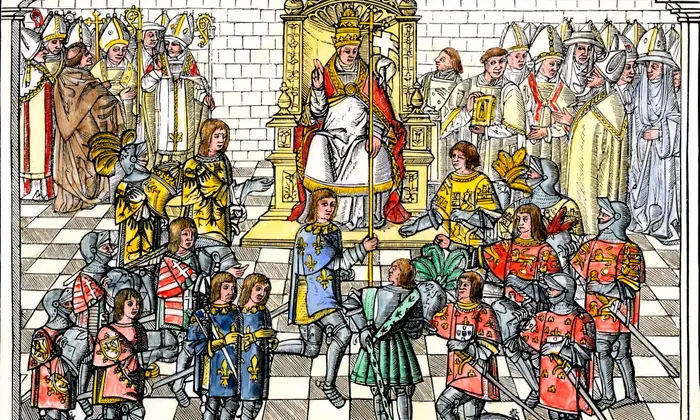
Pope Urban II at the Council of Clermont (1095) calling for a crusade
against the Muslims ruling the Eastern Holy Lands
|
The First Crusade (1096-1099)
Planning and organizing such a major undertaking fell to a number of
individuals, mostly European noblemen of fairly high rank (kings,
however, did not participate in this first crusade).
An exception
was Peter the Hermit, who organized a huge band of common soldiers and
peasants, and marched them through southeastern Europe to
Constantinople. Rather than await the rest of the crusader force,
Peter's soldiers insisted on pushing on ahead toward their goal of
Jerusalem – so confident were they that God was going to bless their
rather unruly undertaking with glorious victory. But instead of
victory, they walked into a Turkish ambush at Cibotus (August 1096) and
were annihilated.
There were other rather spontaneous massings of commoner crusaders, but
most of those failed even to reach Constantinople. A much more
organized undertaking originating in the French-German borderlands was
led by Duke Godfrey of Bouillon and his brothers Baldwin and Eustice
and their cousin Baldwin of Le Bourg. Another group, mostly
Norman in character, was organized in Southern Italy by Bohemond, son
of the notorious Norman raider Robert Guiscard. Another largely
Norman group was led by Robert of Flanders, his cousin Robert of
Normandy, Stephen of Blois and Tancred, nephew of Bohemond. A
fourth group from southern France was led by Count Raymond of St.
Gilles and Bishop Adhemar – who together had been commissioned by the
Pope to be the overall leaders of the crusade. All of these
French speaking noblemen would set an indelible mark on the crusading
tradition, in that the crusaders' land holdings in the Holy Lands would
eventually become known as "Frankish" domains.
With about 4,000 knights and 25,000 foot-soldiers they left
Constantinople for the Holy Lands in May of 1097. With the
assistance of Greek warriors, they began to throw back the Turks that
came out to meet them as they advanced through Asia Minor. By
October they reached Antioch. (Baldwin broke company with the
crusaders to join the Armenians and take command of the all important
city of Edessa in eastern Syria) Not until next June did their
siege of Antioch finally bring the collapse of the city, as Bohemond
was finally able to breach the walls and lead his troops – to a
massacre of the Muslim inhabitants of the city. But the Antioch
citadel held out – though a relief force of Muslims was thrown back by
the crusaders. At the end of the month the Muslim defenders
surrendered the Antioch citadel under a promise of safe conduct if they
left the city. So the city was delivered into the hands of
Bohemond. But the victory was spoiled by an epidemic that broke
out among the crusaders, taking the life of Bishop Adhemar.
Early the following year (1098) the other crusader leaders and their
armies set out for Jerusalem (accompanied by the fiery preacher, Peter
the Hermit). Here they encountered not the Seljuk Turks (Sunni
Muslims) but the Fatimids (Shi'ite Muslims) from Egypt, who had
recently seized Jerusalem from the Turks. Despite the crusaders'
greatly reduced numbers (about half of what they had left
Constantinople with) they were able to breach the walls of Jerusalem in
mid-July – and proceeded to massacre the city's Muslim and Jewish
inhabitants – despite Tancred's efforts to hold the crusaders to a
promise of safe conduct he had given the city's leaders.2
2The
sheer barbarity of the crusaders shook the Muslim sense of religious
toleration of the Christian communities in their midst ... and
eventually the word "crusader" would become for the Muslim a term of
sheer ugliness and spite, representing in the mind of the Muslim the
lurking danger of barbarity in the Christian heart.
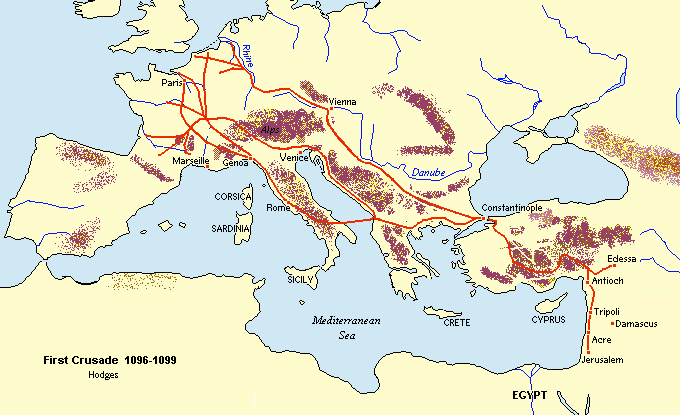
EFFORTS TO
CONSOLIDATE THE VICTORY |
Soon
thereafter most of the crusaders, having completed their "pilgrimage,"
departed for home, including the crusade's leader, Raymond.
Godfrey was then elected to serve as Jerusalem's new ruler. But
Godfrey's death two years later brought his brother Baldwin from Edessa
to take the position, now termed "king" of Jerusalem (he turned Edessa
over to his cousin Baldwin of Le Bourg).
Within the next ten years, aided in part by more crusaders coming from
Europe, Baldwin was able to extend the crusader holdings up and down
the Eastern Mediterranean coast (except Ascalon and Tyre). Then
in 1109 a fourth crusader state, Tripoli, was added to the crusader
states of Edessa, Antioch and Jerusalem. Tripoli was led by a
descendant of Raymond of St. Gilles (who had died in 1105). With
the acquisition of Tyre in 1024, this would be the greatest extent of
the crusader holdings in the Holy Land.3
Whereas the strong competition between the Sunni Turks to the North and
the Shi'ite Fatimids to the South allowed the crusaders to use
diplomacy to fend off Muslim threats from these two directions, a new
challenge arose from the East in the 1130s from the Muslim governor of
Mosul, Zangi. Improved diplomatic relations with the Muslims of
Damascus allowed the next generation of crusaders (who were quickly
adapting themselves to the political style of the surround Muslim
world) to prevent Zangi from achieving a strategic advance against
nearby Damascus. But the crusaders were unable to stop his
assault on Edessa, which fell to Zangi in 1144. This was huge
loss for the crusaders – and a shock to the Christians of Western
Europe when news of the loss reached them.
Meanwhile a similar crusade was undertaken in Spain and Portugal
against the Umayyads, taking a number of key cities (importantly,
Lisbon and numerous Spanish cties) also around the mid-1100s.
3The promise of the crusaders to restore to the Byzantine emperor land taken from the Muslims was completely ignored.
Of
course the Crusaders were not finished ... and fought back, recovering
some of the lost territory. Needless to say, there would be
little peace in the land between the Crusader Kingdoms and the Muslim
principalities. Thus more crusades were commissioned by future
popes, involving now German and French kings and even the Holy Roman
(Western) Emperor.
The crusaders fared poorly in their efforts to expand their conquest to
Fatimid Egypt, thanks largely to the military skill of Saladin, a Sunni
Kurd serving as vizier to the Shi’ite caliph al-Adid. With
al-Adid’s death in 1171 Saladin took personal control of Egypt,
submitted his territory to Sunni Abbasid authority (stirring Fatimid
revolts, which he crushed) ... and then took on the crusader states,
regaining control of Syria for Islam in 1182 and Palestine in 1187.
The crusaders, however, were able to take the strongly fortified city
of Acre in 1191 and hold that position – along with similar fortresses
in Palestine – for another century. But they would actually
exercise little control beyond the walls of those fortresses.
Of course further efforts (additional crusades) were made to restore
the lost crusader kingdoms, engaging now even the royalty of
Europe. But the efforts came to little ... except to introduce
European courts to the wealth and splendor of the Muslim courts, which
now became something of cultural models to the primitive Europeans.
The crusading monks
Interestingly, the crusades also brought the creation of
religious-military orders (such as the Knights Templar and the Knights
Hospitaller) ... something like fighting monks, or at least warriors
who had taken a solemn vow of a life of service to the cause.
These military-priest orders would become wealthy and powerful in their
own right ... so much so that they drew the ire and eventually
persecution of a number of suspicious or envious European kings and
dukes.
The Knights Templar, founded in 1118 in Jerusalem, was a holy order of
knights (soon ordained even by Pope Honorius II in 1128), involved not
only in fighting the Muslim "infidel" in the Holy Land (only about 10%
of their order was actually engaged this way) but in collecting monies
for various charities. They became so skilled in this latter
venture, developing sophisticated banking techniques and placing
themselves strategically all across Christendom (Europe plus the
crusader holdings in the Middle East) that the Knights Templar order
became vastly rich.
This then began to stir the envy and fear of Europe's various dukes and
princes … who became increasingly resentful of the Templars.
Finally in 1307, using the secrecy by which they operated as his
excuse, French King Philip IV (deeply in debt to the Templars) had the
leaders of this order arrested, tortured (seeking to get "proper"
confessions out of them), and burned at the stake. Then five
years later he pressured Pope Clement V to officially disband the order.
Surviving the realm of European politics better than the Templars was
the Order of the Knights Hospitaller, formed actually a bit earlier in
Jerusalem – even before the first of the crusades – from the
foundations of a Benedictine hospital located in Jerusalem … by monks
who had committed themselves to taking care of the sick and poor who
came to Jerusalem as pilgrims. Then with the conquest of
Jerusalem in 1099 by the crusaders, the monks were joined by various
knights in forming a new order (also chartered by the pope), the
Kinghts Hospitaller, dedicated to defending and caring for the
Christian community in the Holy Land.
The order was ultimately forced to move to the island of Rhodes when Muslims first retook the Holy Lands in the late 1100s.
But the order continued to survive as the ruling authority in Rhodes
and then later at Malta … then eventually in Sicily as a vassal state
under Spanish authority. The Hospitallers would not draw the
resentment of Europe's monarchs … and would continue to serve Europe
charitably. However, the split in the Church that occurred
during the Protestant Reformation of the 1500s would also divide the
order – portions of which still survive down to today.
The urban Republic of Venice gets in on the act
Included (from the 1120s onward) in this great crusading venture were
also soldiers and sailors from the rising city-state (or Republic) of
Venice, strategically located at the top of the northeastern coast of
Italy. This just happened to be the best jumping off point for
central Europeans to reach the Holy Lands by water rather than the long
and hazardous overland journey through the unfriendly Balkans and the
wary Byzantine lands. It also happened to be well protected
by the fact that Venice was actually a maze of offshore islands,
virtually impossible to reach by a land army ... and well protected by
a massive navy.
The ongoing crusading effort
Times of truce between Christians and Muslims would occur ... followed
by the resumption of fighting, frequently as a result of a call of a
pope to yet another crusade (4th, 5th, 6th) ... on into the mid
and late 1200s.
Even the Byzantines got caught on the wrong end
of the crusades, especially the 4th (1202-1204) which seems to have
been waged only against the fellow-Christian Byzantine Greeks under the
orders of the Venetian authorities for whom the sacking of
Constantinople was the price exacted on the crusaders in order to have
Venice's ships then take them on to the Holy Lands (they never made it
there ... but did cripple Byzantine power greatly.
|
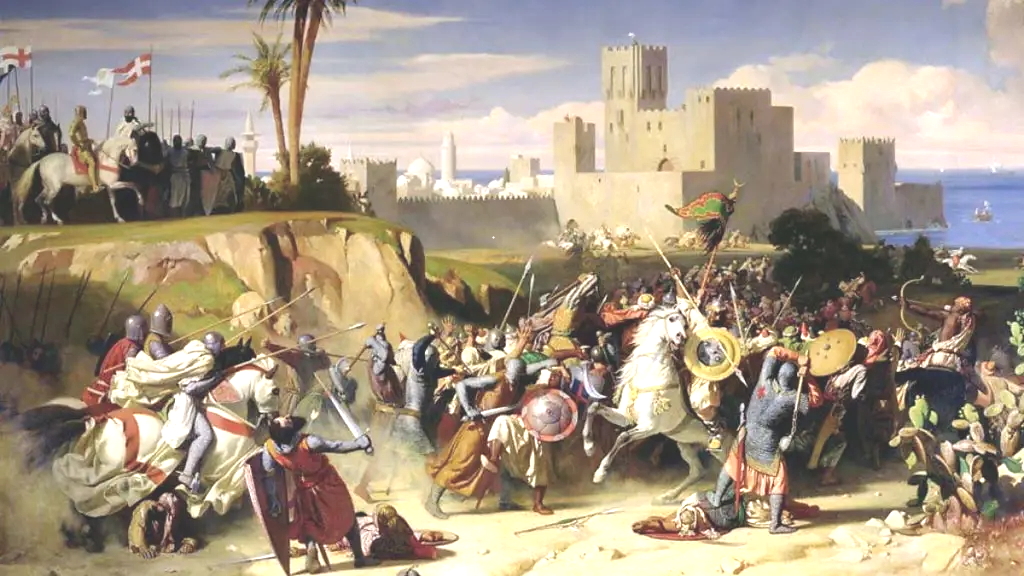
The Siege of Acre (Third Crusade) 1187-1191
The crusaders bring Acre to surrender when a Muslim relieving force
under Saladin fails to drive off the crusaders
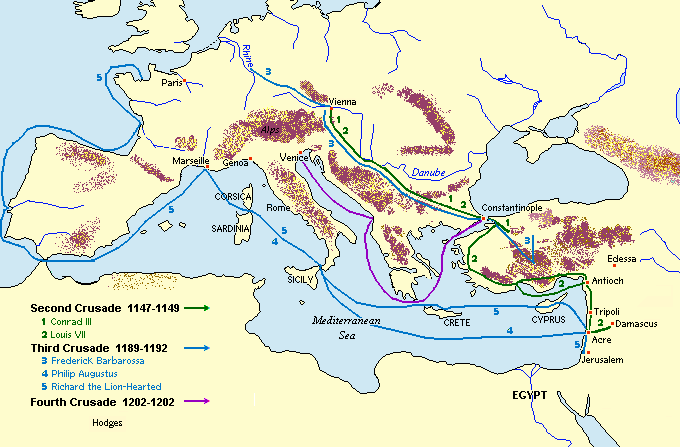
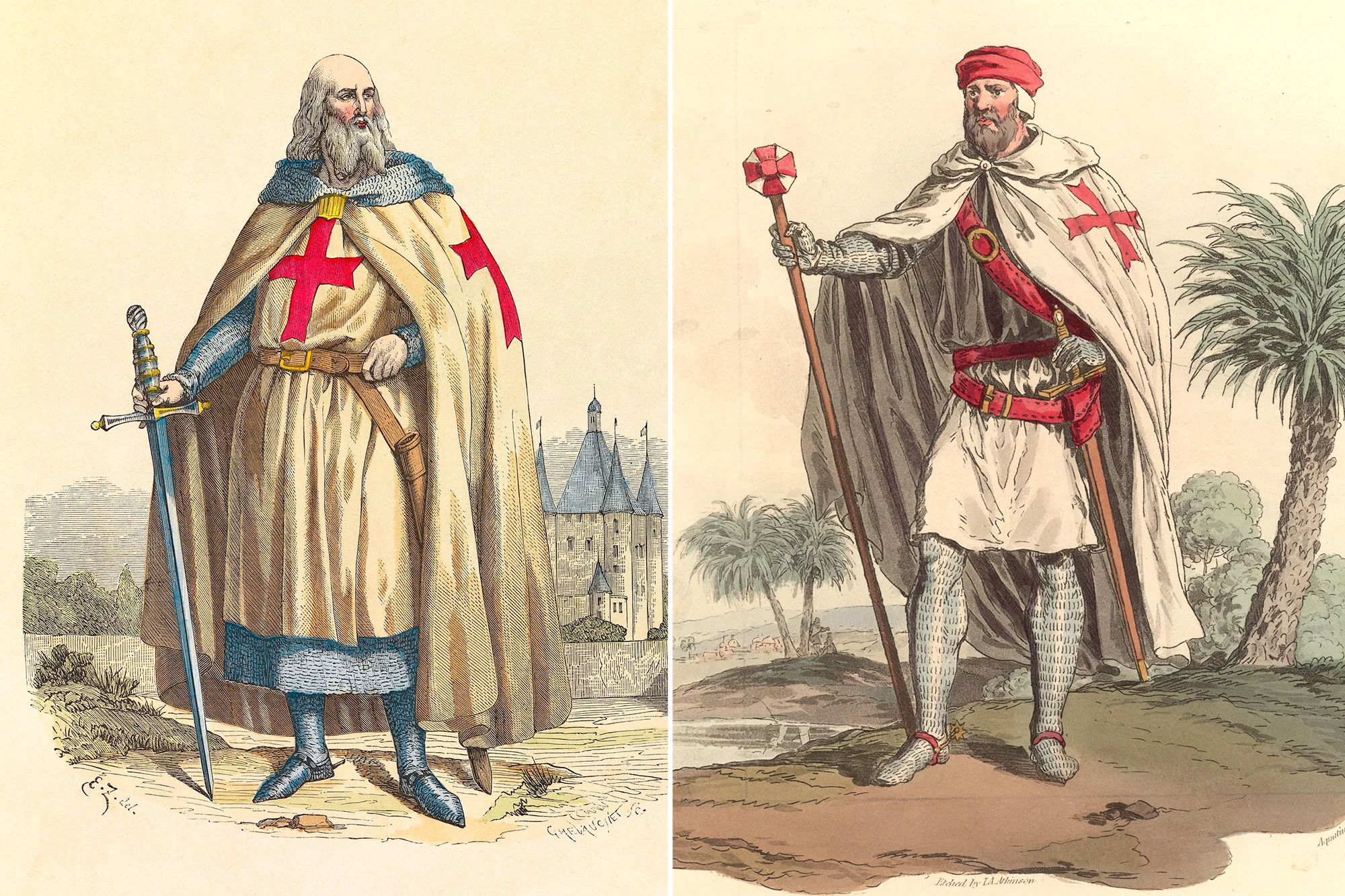
Knights Templar
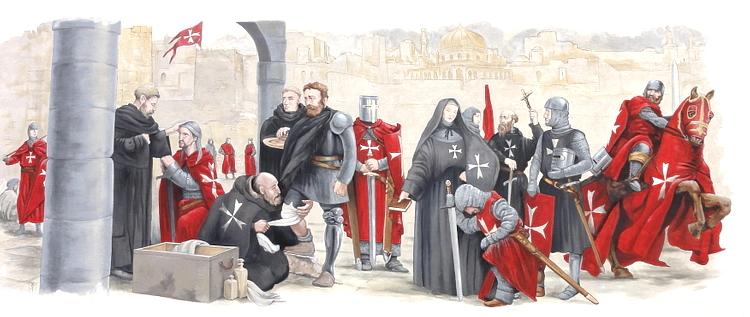
Knights Hospitallers taking care of fellow crusaders
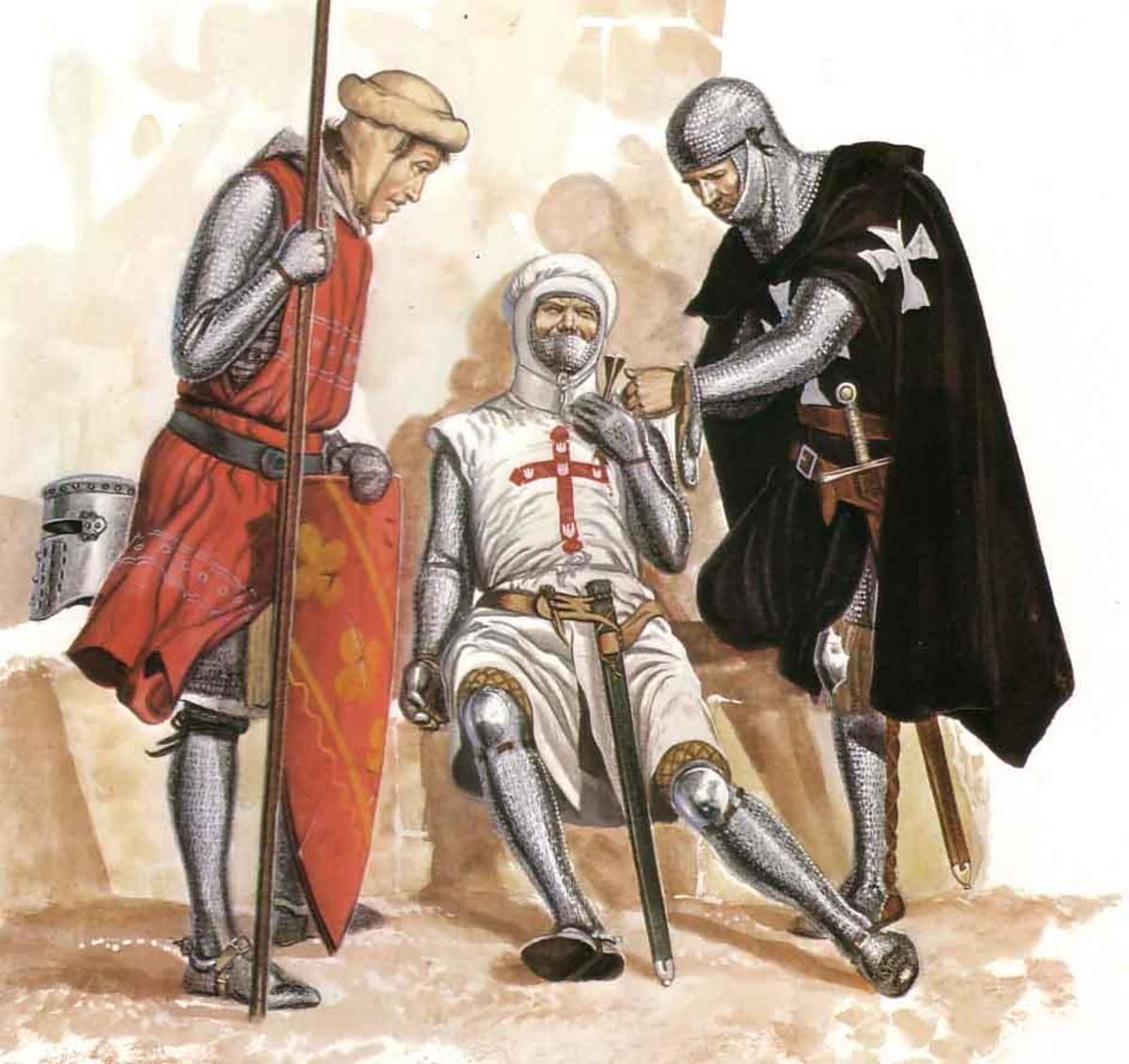
A knight Hospitaller caring for a wounded fellow crusader
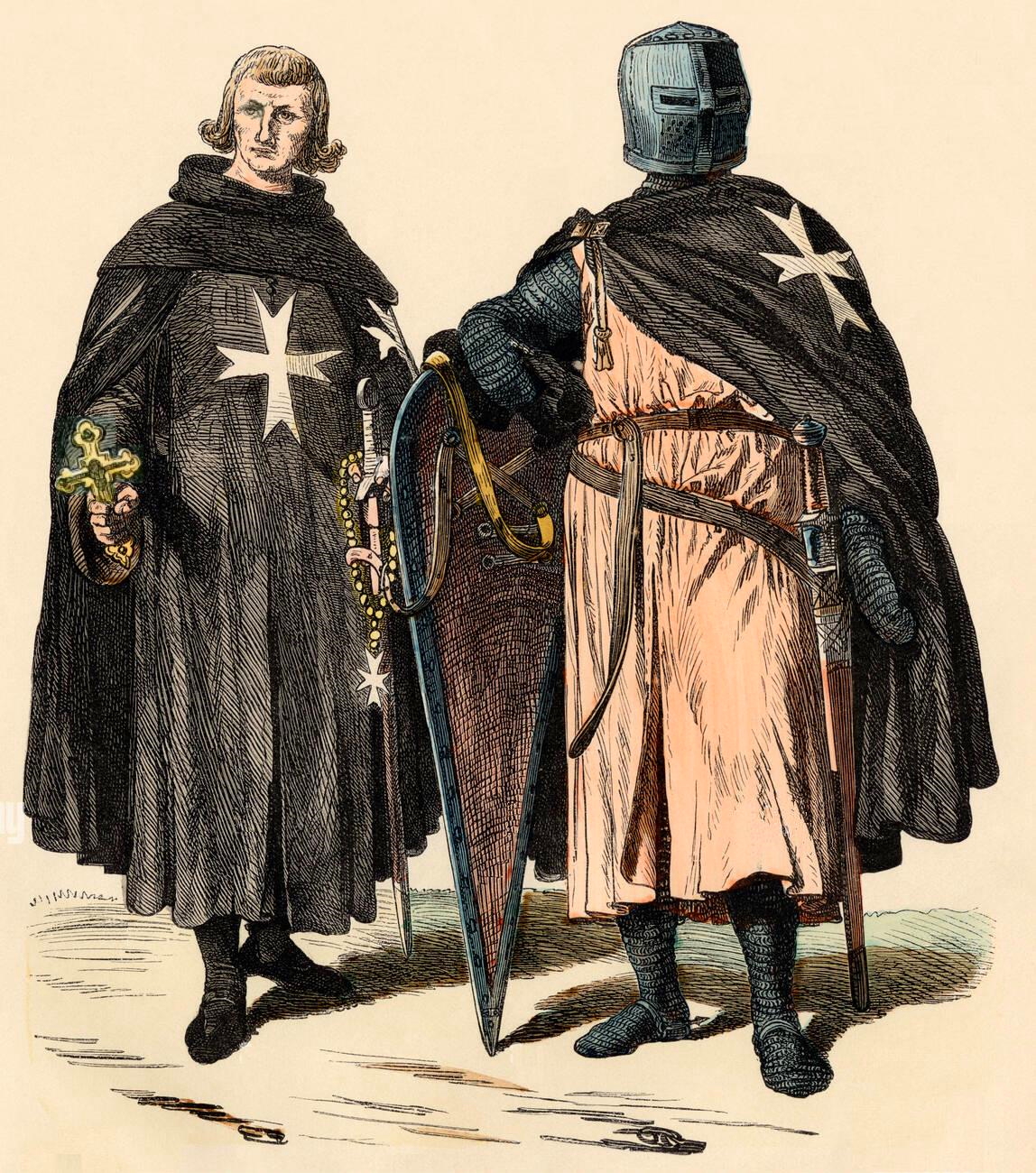
Knights Hospitaller could also fight
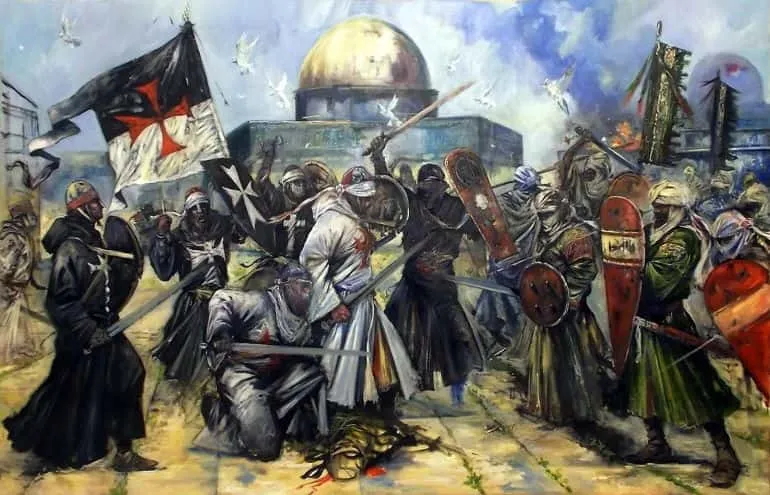
Knights Hospitaller fighting Muslim troops in Jerusalem
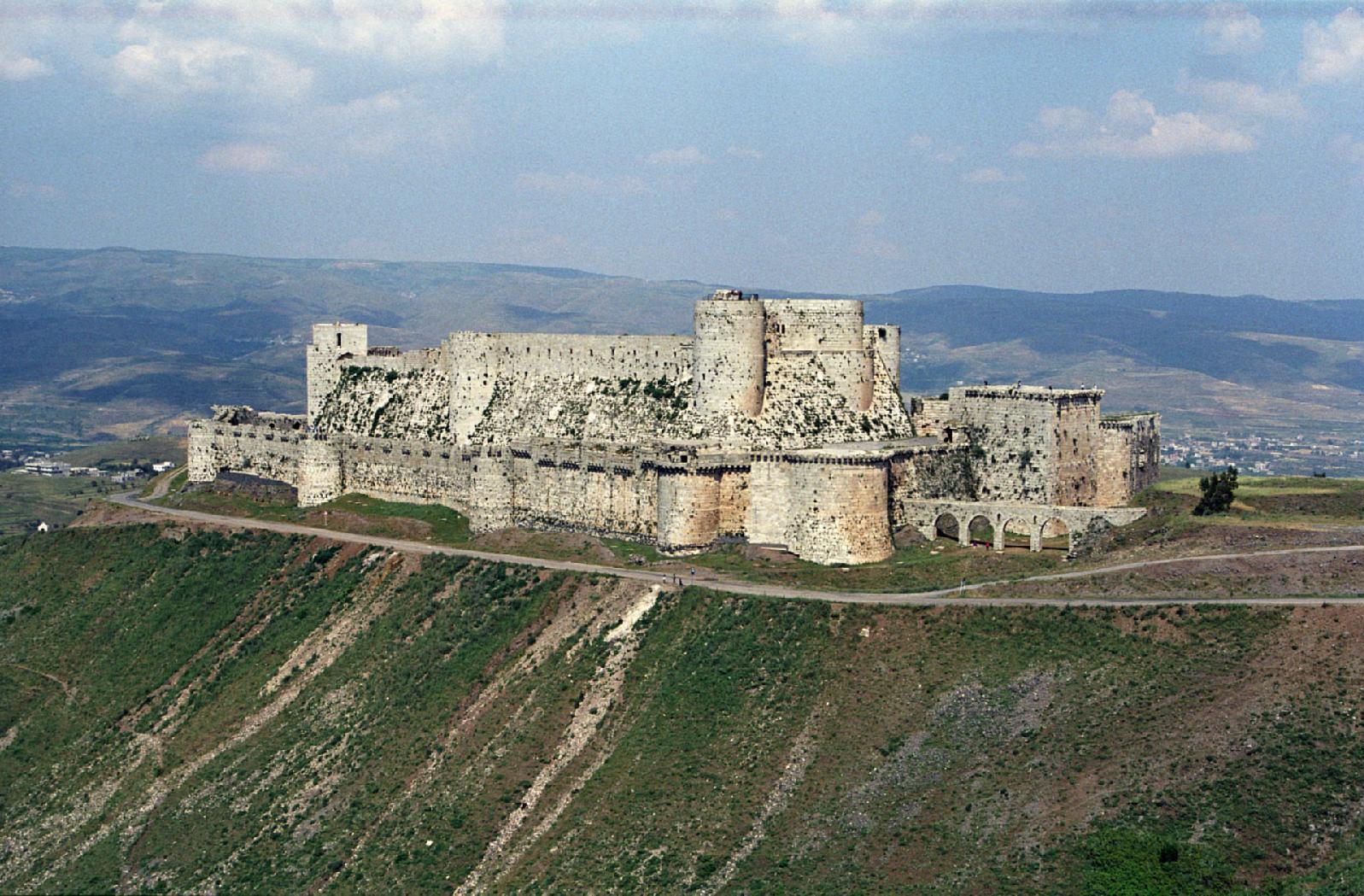
Krak des Chevaliers - Fortress of the Knights Hospitallers in
Syria
Built by the Knights
Hospitallers beginning in 1140
and held by them until the castle fell to the
Mamluks in 1271
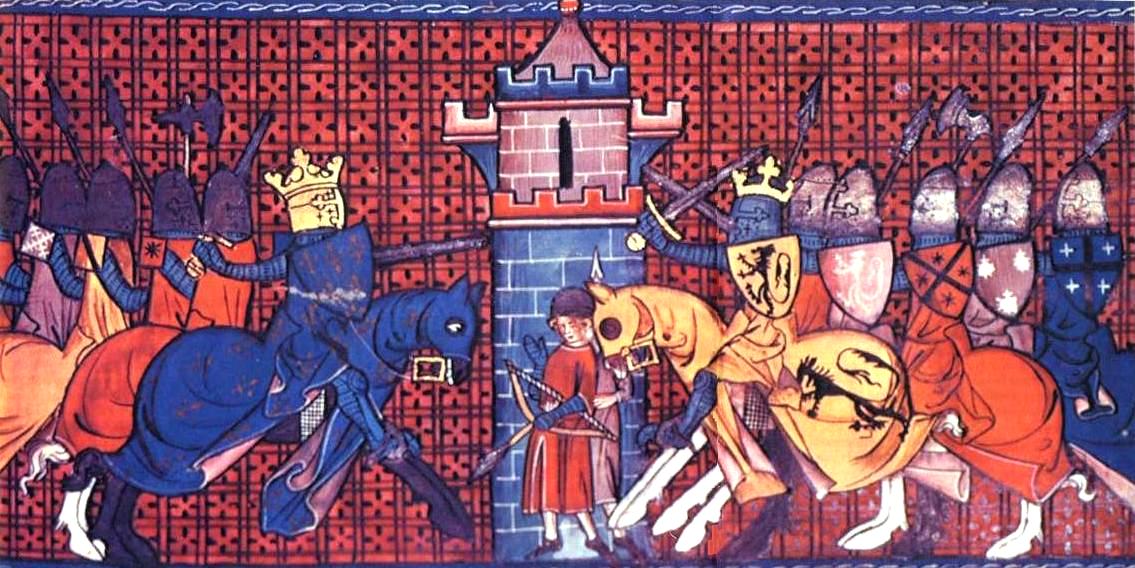
King Philip II Augustus of
France fighting Richard
(Plantagenet) the
Lionhearted
(In France, Richard was merely the Duke of Normandy ... but in England,
the country's king) - 1198

Philip II Augustus
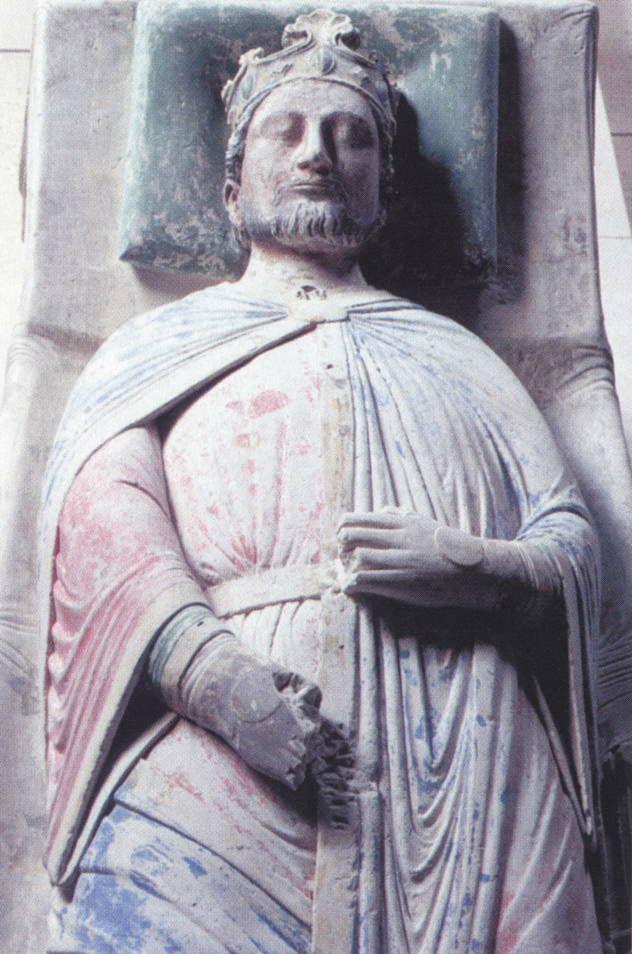
Richard the Lionheart

Go on to the next section: Growing Urban Power
 Miles
H. Hodges Miles
H. Hodges
| | | |


 The First Crusade (1095-1098)
The First Crusade (1095-1098)
 Efforts to consolidate the victory
Efforts to consolidate the victory















